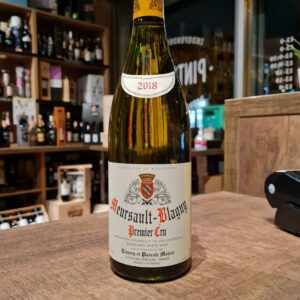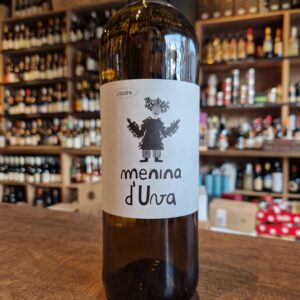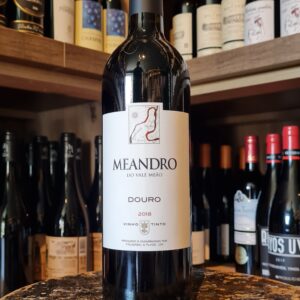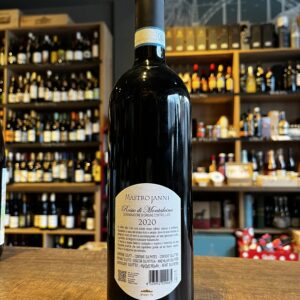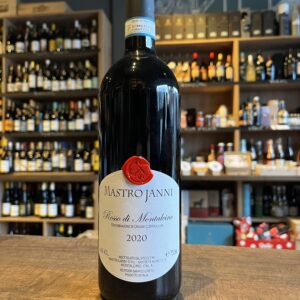-
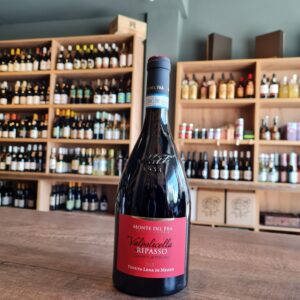 The Monte del Fra Valpolicella Classico appears deep ruby red with ripe red fruit accompanied with spice and earthiness on the nose. The palate displays delicious cherry and plum fruit, locked with sweet liquorice and warm cinnamon, finishing full, with velvety soft tannins and spice. Excellent wine that will get better and better, allow to breathe, even decant and would be best served with roasts, stews, braised meats and strong cheese.
The Monte del Fra Valpolicella Classico appears deep ruby red with ripe red fruit accompanied with spice and earthiness on the nose. The palate displays delicious cherry and plum fruit, locked with sweet liquorice and warm cinnamon, finishing full, with velvety soft tannins and spice. Excellent wine that will get better and better, allow to breathe, even decant and would be best served with roasts, stews, braised meats and strong cheese. -
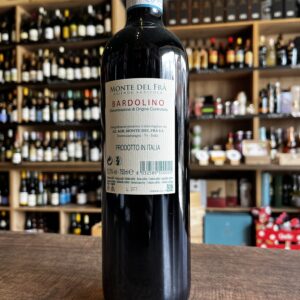
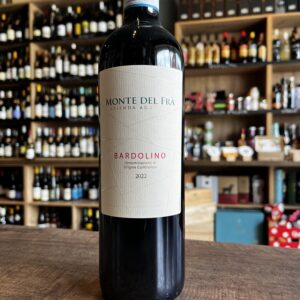 This wine is from the hills that are located in a Guyot at 100/150 meters above sea level, of morainic origin with calcareous, clayey, gravelly, sandy soil.From the municipality of Sommacampagna located southeast of Lake Garda.A well-balanced, fresh and easy-drinking style dry and rounded red wine. Delicately fruity and fragrant, with notes of cherries, strawberries, raspberries and red currants as well as hints of spices. Recommended with light snacks, cold cuts, light meals, tapas, pasta and fish in general (particularly freshwater fish).
This wine is from the hills that are located in a Guyot at 100/150 meters above sea level, of morainic origin with calcareous, clayey, gravelly, sandy soil.From the municipality of Sommacampagna located southeast of Lake Garda.A well-balanced, fresh and easy-drinking style dry and rounded red wine. Delicately fruity and fragrant, with notes of cherries, strawberries, raspberries and red currants as well as hints of spices. Recommended with light snacks, cold cuts, light meals, tapas, pasta and fish in general (particularly freshwater fish). -
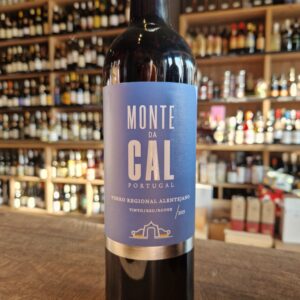 It is in the heart of the genuine Alentejo, with its unique aromas, flavors and textures, nature, silence and immensity, that the 80 hectares of vineyards at Herdade Monte da Cal, located in the municipality of Fronteira, in the parish of São Saturnino, extend over 80 hectares of vineyards. about 40 km from Portalegre. Surrounded by the tranquility of the northern Alentejo plain, it is part of the calm environment of nature characteristic of this part of the country, surrounded by an infinity of vineyards, which we can only see, far away. Here, the red varieties Trincadeira, Syrah, Aragonês, Alicante Bouschet, Alfrocheiro and Touriga Nacional are planted. The architecture and decoration of the estate reflect the Arab influences, so present in the Alentejo culture. The estate’s modern winery is a fundamental pillar to reinforce the visibility of the wines of this house, and a wine tourism project is already planned for this property. Suggested pairing with dishes from the Mediterranean, Chinese, Indian and African cuisine.
It is in the heart of the genuine Alentejo, with its unique aromas, flavors and textures, nature, silence and immensity, that the 80 hectares of vineyards at Herdade Monte da Cal, located in the municipality of Fronteira, in the parish of São Saturnino, extend over 80 hectares of vineyards. about 40 km from Portalegre. Surrounded by the tranquility of the northern Alentejo plain, it is part of the calm environment of nature characteristic of this part of the country, surrounded by an infinity of vineyards, which we can only see, far away. Here, the red varieties Trincadeira, Syrah, Aragonês, Alicante Bouschet, Alfrocheiro and Touriga Nacional are planted. The architecture and decoration of the estate reflect the Arab influences, so present in the Alentejo culture. The estate’s modern winery is a fundamental pillar to reinforce the visibility of the wines of this house, and a wine tourism project is already planned for this property. Suggested pairing with dishes from the Mediterranean, Chinese, Indian and African cuisine. -
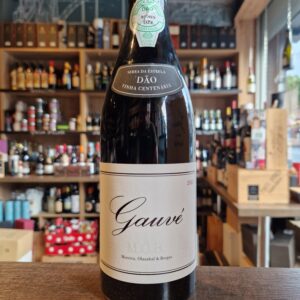 This project was born from the will of three winemakers, Jorge Moreira, Francisco Olazabal and Jorge Serôdio Borges, to make a wine together. The chosen region was the Dão, a region for which there is a common admiration that was born in the tasting of older wines, from the 60s and 70s that surprise for their elegance and freshness. The identity and complexity of these wines is indeed remarkable and serves as an inspiration for MOB wines.
This project was born from the will of three winemakers, Jorge Moreira, Francisco Olazabal and Jorge Serôdio Borges, to make a wine together. The chosen region was the Dão, a region for which there is a common admiration that was born in the tasting of older wines, from the 60s and 70s that surprise for their elegance and freshness. The identity and complexity of these wines is indeed remarkable and serves as an inspiration for MOB wines. -
Out of stock
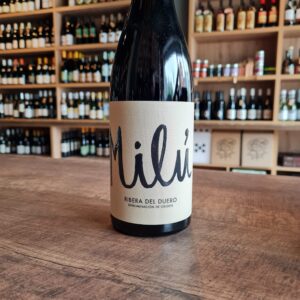 A rich and satisfying Ribera del Duero red, from a quality focussed micro producer Quinta Milú. This is a family run project in the Ribera del Duero from the Asturian viticulturist Germán R. Blanco. A small project which for nearly 10 years now has looked for wines which tell us about where they were born, a small village by the name of La Aguilera situated in the province of Burgos. Germán makes his elegant, fruit-forward wines using foot-treading, wild yeast fermentation and minimal handling. Not filtered, not clarified and not stabilized is his ethos. All his wines share a delicious rusticity, purity of fruit, and incredible freshness. Germán calls this— his flagship wine— a “vino de pueblo”, which translates as “a wine for every day and for everyone.” Pair it with braised meats, steak, game, lamb, root veggies, hard cheese or just have it on its own.
A rich and satisfying Ribera del Duero red, from a quality focussed micro producer Quinta Milú. This is a family run project in the Ribera del Duero from the Asturian viticulturist Germán R. Blanco. A small project which for nearly 10 years now has looked for wines which tell us about where they were born, a small village by the name of La Aguilera situated in the province of Burgos. Germán makes his elegant, fruit-forward wines using foot-treading, wild yeast fermentation and minimal handling. Not filtered, not clarified and not stabilized is his ethos. All his wines share a delicious rusticity, purity of fruit, and incredible freshness. Germán calls this— his flagship wine— a “vino de pueblo”, which translates as “a wine for every day and for everyone.” Pair it with braised meats, steak, game, lamb, root veggies, hard cheese or just have it on its own. -
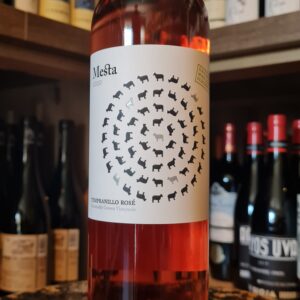 Mesta is a range of organically and sustainably grown single varietal wines, which stylishly showcase the Spanish wine revolution under the symbol of the Mesta. Mesta was a powerful alliance of sheep ranchers in medieval Castile, who controlled the cañadas: the traditional rights of way for migrating sheep. To this day the cañadas are protected from being blocked or built upon, a reminder of ancient rights and a model of coexistence with nature. This modern range, from the fashionable DO Uclés in central Castile, offers wines of great purity and varietal typicity.A versatile wine which accompanies spicy dishes perfectly, Asian curries, seafood risotto or a light salad with grilled prawns. Rosé wines are in fashion not just in the summer but also throughout the year, and this beautiful Mesta Rosé is a serious contender in the Rosé world. Especially at this price!!!
Mesta is a range of organically and sustainably grown single varietal wines, which stylishly showcase the Spanish wine revolution under the symbol of the Mesta. Mesta was a powerful alliance of sheep ranchers in medieval Castile, who controlled the cañadas: the traditional rights of way for migrating sheep. To this day the cañadas are protected from being blocked or built upon, a reminder of ancient rights and a model of coexistence with nature. This modern range, from the fashionable DO Uclés in central Castile, offers wines of great purity and varietal typicity.A versatile wine which accompanies spicy dishes perfectly, Asian curries, seafood risotto or a light salad with grilled prawns. Rosé wines are in fashion not just in the summer but also throughout the year, and this beautiful Mesta Rosé is a serious contender in the Rosé world. Especially at this price!!! -
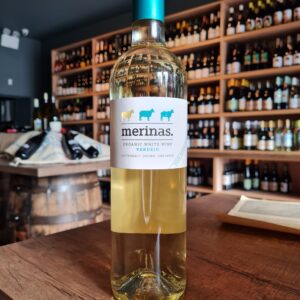 Merinas comes from the Bodegas y Viñedos Fontana, located in the town of Cuenca. The name Merinas is also a reference to the merino sheep, the most famous sheep breed in the world which, incidentally, sometimes seems to scurry around in the vines. A crisp, aromatic white wine, showing great purity of aromas and a precise expression of the Verdejo grape. Bright, pale straw yellow, with intense, fresh notes of grass, fennel and white pepper. Dry but juicy on the palate, with excellent balance, a moderate alcohol of only 12,5% with a persistent, slightly mineral finish. Excellent as an aperitif and with pasta, salads, poultry and fish dishes.
Merinas comes from the Bodegas y Viñedos Fontana, located in the town of Cuenca. The name Merinas is also a reference to the merino sheep, the most famous sheep breed in the world which, incidentally, sometimes seems to scurry around in the vines. A crisp, aromatic white wine, showing great purity of aromas and a precise expression of the Verdejo grape. Bright, pale straw yellow, with intense, fresh notes of grass, fennel and white pepper. Dry but juicy on the palate, with excellent balance, a moderate alcohol of only 12,5% with a persistent, slightly mineral finish. Excellent as an aperitif and with pasta, salads, poultry and fish dishes. -
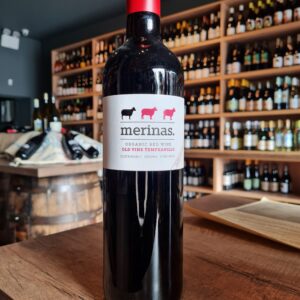 The Mesta was a powerful alliance of shepherds in medieval Castile, who controlled the “cañadas”: traditional rights-of-way for migrating sheep. to this day, the “cañadas” are protected from being blocked or built upon. Our vineyards are nestled deep in the land of The Mesta, and are still passed over by flocks on their annual migration – a reminder of ancient rights, and a cultural cue for continued co-existence with nature. Produced from organically farmed vineyards in Uclés (Castile, Spain). Managed as an integrated ecosystem and studded with centenary oak trees. The continental climate with sunny days and cool nights allow us to achieve intense fruit and excellent varietal definition, while retaining remarkable freshness Mesta Tempranillo is a vibrant and juicy, unoaked red wine, showing great purity and the typicity of high-altitude Tempranillo, with expressive and well-defined aromas of red berries, rosemary and a touch of liquorice. Bright ruby red colour. Fresh and with an excellent persistence on the palate, with round texture and a satisfyingly dry finish. Very versatile, medium-bodied food wine, excellent with tapas, grilled meat and pasta.
The Mesta was a powerful alliance of shepherds in medieval Castile, who controlled the “cañadas”: traditional rights-of-way for migrating sheep. to this day, the “cañadas” are protected from being blocked or built upon. Our vineyards are nestled deep in the land of The Mesta, and are still passed over by flocks on their annual migration – a reminder of ancient rights, and a cultural cue for continued co-existence with nature. Produced from organically farmed vineyards in Uclés (Castile, Spain). Managed as an integrated ecosystem and studded with centenary oak trees. The continental climate with sunny days and cool nights allow us to achieve intense fruit and excellent varietal definition, while retaining remarkable freshness Mesta Tempranillo is a vibrant and juicy, unoaked red wine, showing great purity and the typicity of high-altitude Tempranillo, with expressive and well-defined aromas of red berries, rosemary and a touch of liquorice. Bright ruby red colour. Fresh and with an excellent persistence on the palate, with round texture and a satisfyingly dry finish. Very versatile, medium-bodied food wine, excellent with tapas, grilled meat and pasta. -
 Menina d’Uva is a small winery located in Uva, a remote village in the quiet and desolate countryside of the Northeast of Portugal. Female winemaker Aline Domingues moved from Paris to this area from which her parents had emigrated to Paris to give their children better opportunities. A controversial move within the family but one that I wholeheartedly support. Aline clearly is a talented winemaker crafting beautifully pure wines. Made from 70% red grapes (including Bastardo, known in the Jura as Trousseau) and 30% white grapes including Malvasia and white Bastardo. It’s still a hearthy red that’s crispy and refreshing; cherries, pomegranate with a beautiful smell of the forest. Highly recommended.
Menina d’Uva is a small winery located in Uva, a remote village in the quiet and desolate countryside of the Northeast of Portugal. Female winemaker Aline Domingues moved from Paris to this area from which her parents had emigrated to Paris to give their children better opportunities. A controversial move within the family but one that I wholeheartedly support. Aline clearly is a talented winemaker crafting beautifully pure wines. Made from 70% red grapes (including Bastardo, known in the Jura as Trousseau) and 30% white grapes including Malvasia and white Bastardo. It’s still a hearthy red that’s crispy and refreshing; cherries, pomegranate with a beautiful smell of the forest. Highly recommended. -
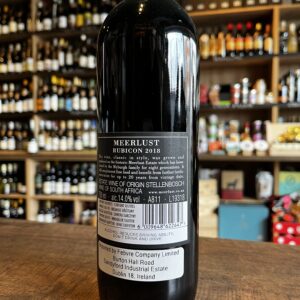
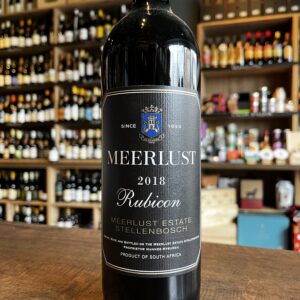 Meerlust Rubicon had a great impact on the history of South African wine. First made in 1980, it essentially set the pattern for Bordeaux blends in the country. There was of course a few pioners at this front that only used Cabernet Sauvignon varietal such as Kanonkop (Paul Sauer) in 1973 but as a blend as per Bordeaux style Meerlust changed the scene. According to Hannes Myburgh, his father was inspired by Julious Cesar words “Alea iacta est. The die is cast,” leading his troops towards Rome in 49BC. As this was a irreversable moment in history as there was no turning back after crossing the Rubicon river as this profoundly shifted Roman politics. Nico Myburgh from the 7th generation of the Meerlust estate and father of the current custodian, was holidaying in Bordeaux when he discovered that the terroir in this area of France was similar to that of the Eerste River Valley. Both have a distinctive climate, characterised by a cooling sea breeze. And both have a soil structure made up of decomposed granite and clay. The red wines produced by the two regions, however, were very different. Unlike the Western Cape’s specified cultivars, Bordeaux thrived on producing blends. Nico returned to Meerlust, filled with inspiration and the desire to create a blend of his own that would match those of the French. In 1980, after several years of experimentation together with winemaker Giorgio Dalla Cia, he announced the birth of the new blend. With proportions of 70% Cabernet Sauvignon, 20% Merlot and 10% Cabernet Franc, a new style of wine had been created in South Africa. Like Caesar, there could be no turning back. Nico and Giorgio had already considered a number of names for the new blend when Professor Dirk Opperman from the University of Stellenbosch, a friend of Nico’s suggested that “Rubicon” might be appropriate. The pair had, after all, crossed a new frontier – and changed the way South Africans thought about red wine. The Cabernet Sauvignon, Merlot, Cabernet Franc and Petit Verdot vineyards are hand harvested from February through to March and each individual vineyard block is kept separate throughout the fermentation process and monitored until the moment of blending.In wintertime, after malolactic fermentation has allowed the personality of each vineyard to assert itself in barrel, the wines are carefully assessed to produce the most expressive, harmonious and complex wine. The blend is assembled and then allowed another year in barrel for the components to harmonise. The wine is finally bottled and left for a further 2 years before release. Rubicon is always released at four years of age and will immediately offer the distinctive character and quality of the Estate. However, further bottle maturation is advised for the intriguing complexity of this classic wine to unfold and reveal itself.The first vintage, the 1980, remains vivacious and very much alive, even 30+ years after vintage. Subsequent vintages all express the personality and characteristics of their specific year. All vintages of Rubicon, however, share the hallmarks of wines grown at this special place: intensity, harmony, vibrancy, complexity and individuality.I suppose we could use here ''Veni, vidi, vici''
Meerlust Rubicon had a great impact on the history of South African wine. First made in 1980, it essentially set the pattern for Bordeaux blends in the country. There was of course a few pioners at this front that only used Cabernet Sauvignon varietal such as Kanonkop (Paul Sauer) in 1973 but as a blend as per Bordeaux style Meerlust changed the scene. According to Hannes Myburgh, his father was inspired by Julious Cesar words “Alea iacta est. The die is cast,” leading his troops towards Rome in 49BC. As this was a irreversable moment in history as there was no turning back after crossing the Rubicon river as this profoundly shifted Roman politics. Nico Myburgh from the 7th generation of the Meerlust estate and father of the current custodian, was holidaying in Bordeaux when he discovered that the terroir in this area of France was similar to that of the Eerste River Valley. Both have a distinctive climate, characterised by a cooling sea breeze. And both have a soil structure made up of decomposed granite and clay. The red wines produced by the two regions, however, were very different. Unlike the Western Cape’s specified cultivars, Bordeaux thrived on producing blends. Nico returned to Meerlust, filled with inspiration and the desire to create a blend of his own that would match those of the French. In 1980, after several years of experimentation together with winemaker Giorgio Dalla Cia, he announced the birth of the new blend. With proportions of 70% Cabernet Sauvignon, 20% Merlot and 10% Cabernet Franc, a new style of wine had been created in South Africa. Like Caesar, there could be no turning back. Nico and Giorgio had already considered a number of names for the new blend when Professor Dirk Opperman from the University of Stellenbosch, a friend of Nico’s suggested that “Rubicon” might be appropriate. The pair had, after all, crossed a new frontier – and changed the way South Africans thought about red wine. The Cabernet Sauvignon, Merlot, Cabernet Franc and Petit Verdot vineyards are hand harvested from February through to March and each individual vineyard block is kept separate throughout the fermentation process and monitored until the moment of blending.In wintertime, after malolactic fermentation has allowed the personality of each vineyard to assert itself in barrel, the wines are carefully assessed to produce the most expressive, harmonious and complex wine. The blend is assembled and then allowed another year in barrel for the components to harmonise. The wine is finally bottled and left for a further 2 years before release. Rubicon is always released at four years of age and will immediately offer the distinctive character and quality of the Estate. However, further bottle maturation is advised for the intriguing complexity of this classic wine to unfold and reveal itself.The first vintage, the 1980, remains vivacious and very much alive, even 30+ years after vintage. Subsequent vintages all express the personality and characteristics of their specific year. All vintages of Rubicon, however, share the hallmarks of wines grown at this special place: intensity, harmony, vibrancy, complexity and individuality.I suppose we could use here ''Veni, vidi, vici'' -
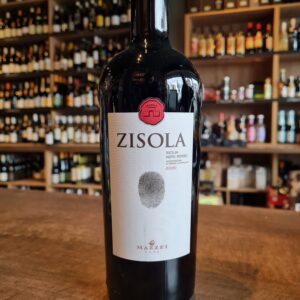 Mazzei is the name of one of the most famous and richest families in the history of Tuscan winemaking, the truth is that their desire to discover and experience other things led them to look for other areas where they could continue their winemaking adventure. So, in 2003, they became aware of the great potential hidden within the Val di Noto region in southeastern Sicily (Italy). A total of 21 hectares of vineyards where Tuscan passion meets Sicilian tradition. Zisola is made only from traditional "Alberello" (bushy) vines grown near Noto, an unique area to make wine. The proximity of the sea and the soil rich in limestone allow to best balance the natural Nero d'Avola exuberance, with a great freshness and elegance. Spicy fish soups, savoury pasta and rice dishes, grilled red meats and vegetables.
Mazzei is the name of one of the most famous and richest families in the history of Tuscan winemaking, the truth is that their desire to discover and experience other things led them to look for other areas where they could continue their winemaking adventure. So, in 2003, they became aware of the great potential hidden within the Val di Noto region in southeastern Sicily (Italy). A total of 21 hectares of vineyards where Tuscan passion meets Sicilian tradition. Zisola is made only from traditional "Alberello" (bushy) vines grown near Noto, an unique area to make wine. The proximity of the sea and the soil rich in limestone allow to best balance the natural Nero d'Avola exuberance, with a great freshness and elegance. Spicy fish soups, savoury pasta and rice dishes, grilled red meats and vegetables. -
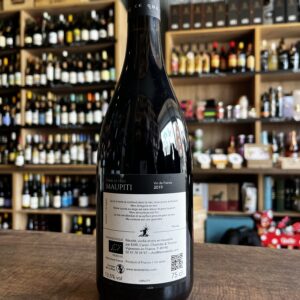
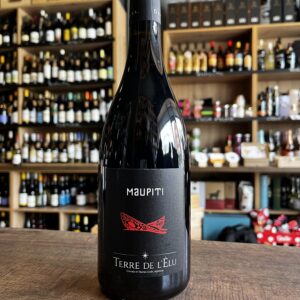 In January 2008, Charlotte and Thomas embarked on a marvelous winemaking adventure with the acquisition of the Clos de l’Élu domain, on the schist-rich lands of the Anjou Noir. With many years’ experience as a wine consultant (Thomas), in the fields of communication and management (Charlotte), they are both deeply passionate about the life of this domain which lies on the finest terroirs of the Layon valley. The 20 hectares are farmed organically and the domain offers a structured range of different wines. If it was the Chenin that attracted Thomas to Anjou, the red grape varieties (Cabernet Franc, Grolleau, Pineau d’Aunis, gamay) continue to inspire him with deep, rich vintages that are expressive and full of finesse. The team is driven by strong convictions, from the work in the vineyard to the cellar, in order to produce wines that truly reflect the terroir. In the vineyards: the whole domain was converted to organic farming in April 2010 (first certified organic vintage in 2013), severe disbudding, appropriate pruning modes depending on the grape variety and plot, soil work, manual harvest in 20 kg boxes, draconian sorting while harvesting. In the cellar: use of gravity as much as possible, natural fermentations, winemaking choice favoring the least manipulation of the grapes possible, winemaking of the reds in whole bunches, maceration and aging in tanks, weathered (or aged) barrels or clay amphorae.
In January 2008, Charlotte and Thomas embarked on a marvelous winemaking adventure with the acquisition of the Clos de l’Élu domain, on the schist-rich lands of the Anjou Noir. With many years’ experience as a wine consultant (Thomas), in the fields of communication and management (Charlotte), they are both deeply passionate about the life of this domain which lies on the finest terroirs of the Layon valley. The 20 hectares are farmed organically and the domain offers a structured range of different wines. If it was the Chenin that attracted Thomas to Anjou, the red grape varieties (Cabernet Franc, Grolleau, Pineau d’Aunis, gamay) continue to inspire him with deep, rich vintages that are expressive and full of finesse. The team is driven by strong convictions, from the work in the vineyard to the cellar, in order to produce wines that truly reflect the terroir. In the vineyards: the whole domain was converted to organic farming in April 2010 (first certified organic vintage in 2013), severe disbudding, appropriate pruning modes depending on the grape variety and plot, soil work, manual harvest in 20 kg boxes, draconian sorting while harvesting. In the cellar: use of gravity as much as possible, natural fermentations, winemaking choice favoring the least manipulation of the grapes possible, winemaking of the reds in whole bunches, maceration and aging in tanks, weathered (or aged) barrels or clay amphorae.Technical Sheet
-
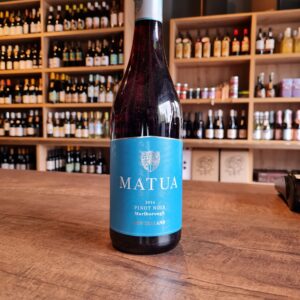 The name Matua, in New Zealand's native Maori language, means "head of the family," an appropriate title given this winery's instrumental role in developing Sauvignon Blanc into what is now New Zealand's most acknowledged wine varietal. You see there’s a couple of regions around the globe that planted Pinot Noir, that have really mastered it and New Zealands' Marlborough is indisputably one of those. It’s funny what a little perseverance does, and from their ragged tin shed in 1974, Bill and Ross Spence began to change the very foundation of wine in not just Marlborough, but New Zealand. They realized that Pinot Noir adapted exceptionally well to the well-drained alluvial soils of Marlborough and it’s unique climate. With the perfect amount of sunshine each day balanced out by cool evenings they struck Pinot Noir gold and have been developing a killer selection ever since. Matua have mastered the perfect balance of fruit-forward freshness with a touch of dry spice, a staple trait of the Marlborough Pinot Noir. You can expect generous aromas of freshly picked strawberries and red with a little ripe plum thrown into the mix. When taking a sip it’s the soft redcurrants, strawberries and cherries that jump out, brought together by a subtle spice, light tobacco and soothing dry earth. A touch of oak gives just enough complexity to enhance the flavors of this incredible wine. Highly Recommended
The name Matua, in New Zealand's native Maori language, means "head of the family," an appropriate title given this winery's instrumental role in developing Sauvignon Blanc into what is now New Zealand's most acknowledged wine varietal. You see there’s a couple of regions around the globe that planted Pinot Noir, that have really mastered it and New Zealands' Marlborough is indisputably one of those. It’s funny what a little perseverance does, and from their ragged tin shed in 1974, Bill and Ross Spence began to change the very foundation of wine in not just Marlborough, but New Zealand. They realized that Pinot Noir adapted exceptionally well to the well-drained alluvial soils of Marlborough and it’s unique climate. With the perfect amount of sunshine each day balanced out by cool evenings they struck Pinot Noir gold and have been developing a killer selection ever since. Matua have mastered the perfect balance of fruit-forward freshness with a touch of dry spice, a staple trait of the Marlborough Pinot Noir. You can expect generous aromas of freshly picked strawberries and red with a little ripe plum thrown into the mix. When taking a sip it’s the soft redcurrants, strawberries and cherries that jump out, brought together by a subtle spice, light tobacco and soothing dry earth. A touch of oak gives just enough complexity to enhance the flavors of this incredible wine. Highly Recommended -
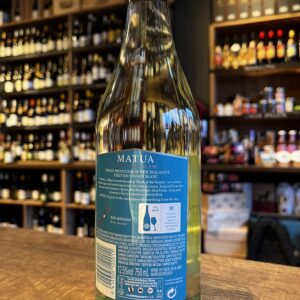
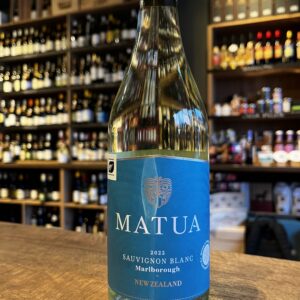 This wine represents the legend of Kupe tangling with a giant octopus who kept stealing all his fish off the hook. During the ensuing fight the beast's tentacles gouged out the Marlborough Sounds and Kupe cut out its eyes which he placed on two rocks known today as Nga Whatu ' The Eyes'. It’s hard to separate New Zealand and Sauvignon Blanc these days, but Matua were the first to put them together, over 40 years ago. You could say They've changed the way the world enjoys white wine. As the Head of the Family (the Maori translation of Matua) They have a tradition of telling stories as a way of passing on knowledge to the next generation. Their most famous winegrowing regions set the scene for some great legendary historical folklore. Wines match dishes from cooked salmon, lettuce, chicken and mushrooms.
This wine represents the legend of Kupe tangling with a giant octopus who kept stealing all his fish off the hook. During the ensuing fight the beast's tentacles gouged out the Marlborough Sounds and Kupe cut out its eyes which he placed on two rocks known today as Nga Whatu ' The Eyes'. It’s hard to separate New Zealand and Sauvignon Blanc these days, but Matua were the first to put them together, over 40 years ago. You could say They've changed the way the world enjoys white wine. As the Head of the Family (the Maori translation of Matua) They have a tradition of telling stories as a way of passing on knowledge to the next generation. Their most famous winegrowing regions set the scene for some great legendary historical folklore. Wines match dishes from cooked salmon, lettuce, chicken and mushrooms. -
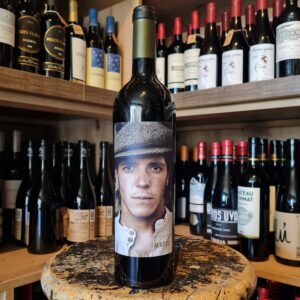 Picaro means 'rogue' or 'rascal'. I have always called it the young lad, as they also have 'El Recio' (the middle aged man) which is Matsu's idea for a reserva wine and the Gran Reserva, 'El Viejo' (old man just in case you didn't know). Bodegas Matsu is situated in the Toro region, right beside the Rueda region (known for the famous Verdejos). Toro wines are predominantly made of Tinta de Toro (tempranillo in this area of Spain) and are well known to be a mouthful of strength and personality due to its poor soil and hot summers. These vines in particular are 90 years old and are cultivated using the biodynamic techniques. Although the more conventional wines of this region are quite sharp, Matsu's wine range has achieved smoothness and elegance. Additionally, the clever thinking behind the labels means that they cater to a wide audience. I would recommend this red any day of the week.
Picaro means 'rogue' or 'rascal'. I have always called it the young lad, as they also have 'El Recio' (the middle aged man) which is Matsu's idea for a reserva wine and the Gran Reserva, 'El Viejo' (old man just in case you didn't know). Bodegas Matsu is situated in the Toro region, right beside the Rueda region (known for the famous Verdejos). Toro wines are predominantly made of Tinta de Toro (tempranillo in this area of Spain) and are well known to be a mouthful of strength and personality due to its poor soil and hot summers. These vines in particular are 90 years old and are cultivated using the biodynamic techniques. Although the more conventional wines of this region are quite sharp, Matsu's wine range has achieved smoothness and elegance. Additionally, the clever thinking behind the labels means that they cater to a wide audience. I would recommend this red any day of the week. -
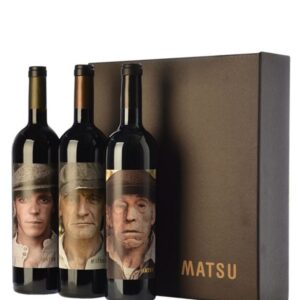 Matsu, the Japanese word for 'wait', pays homage to the generations of devoted wine makers. The images of the real-life wine-producers decorate the bottle and represent the essence of each of the wines. Picaro means 'rogue' or 'rascal', and this rapscallion of a wine is a youthful interpretation of the Toro region's style. El Recio translates as 'the tough guy', and is a more serious, mature wine, made from the product of some of Toro's oldest vines. 'The Old One' of the Matsu range, made from the fruit of selected Tinta de Toro vines, averaging 110 years of age - presented in an original gift box.
Matsu, the Japanese word for 'wait', pays homage to the generations of devoted wine makers. The images of the real-life wine-producers decorate the bottle and represent the essence of each of the wines. Picaro means 'rogue' or 'rascal', and this rapscallion of a wine is a youthful interpretation of the Toro region's style. El Recio translates as 'the tough guy', and is a more serious, mature wine, made from the product of some of Toro's oldest vines. 'The Old One' of the Matsu range, made from the fruit of selected Tinta de Toro vines, averaging 110 years of age - presented in an original gift box. -
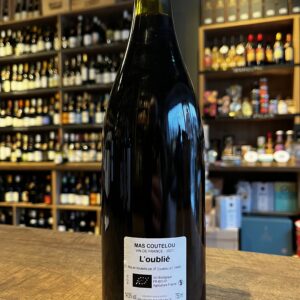
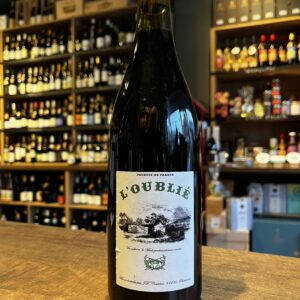 The varieties Jeff grows are all from the south of France, and on his estate located in Puimuisson (a few kilometers from Beziers), the vines coexist with thousands of fruit trees to promote biodiversity. From this base, each vintage offers a range of unique cuvées. Wines he invents at any time following his intuition and that only go onto the market when he considers them representative of the character of the place. Specifically, Mas Coutelou L'Oublié Version is a wine made from Syrah, Carignan and Cinsault vines.
The varieties Jeff grows are all from the south of France, and on his estate located in Puimuisson (a few kilometers from Beziers), the vines coexist with thousands of fruit trees to promote biodiversity. From this base, each vintage offers a range of unique cuvées. Wines he invents at any time following his intuition and that only go onto the market when he considers them representative of the character of the place. Specifically, Mas Coutelou L'Oublié Version is a wine made from Syrah, Carignan and Cinsault vines. -
Out of stock
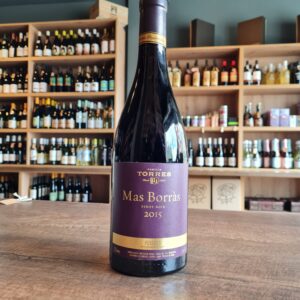 Torres Mas Borras Pinot Noir is a single vineyard wine made from 100% Pinot Noir vines in the Penedès denominación de origen of the Spanish region of Catalonia. The Torres family has been making wine in the ancient Catalán town of Vilafranca del Penedès, south-west of Barcelona, since the 17th Century. It is this tradition combined with innovation, dynamism and commitment to quality that has put Torres firmly on the world map. They remain one of the largest family owned and run wine companies in the world and, under the stewardship of fourth generation Miguel Torres they are committed to sustainable viticulture and green practices. The Torres Mas Borras vineyard is located at 520 metres above sea level in the coolest part of the Upper Penedes area at Santa María de Miralles. At this altitude, the relatively cold summer nights allow a long and balanced ripening, which is desirable for producing elegant and noble Pinot Noir. Deep calcareous clay soils with interspersed layers of gypsum, moderately well drained with a high water holding capacity. Developed over sedimentary material from the Eocene. Thanks to the cool soils and the continental tendency of the climate, these vineyards provide the best conditions for Pinot Noir in the Penedès region. This is why Jacques Bergeret, a Burgundian expert in cultivating Pinot Noir, chose these soils in 1985–1986. The Pinot Noir grapes for this single vineyard wine are usually harvested in late September and are macerated in the skins for 2 weeks after harvest. The wine is fermented in stainless steel with an additional malolactic fermentation in oak barrels. After vinification Torres Mas Borras Pinot Noir is aged in French oak barrels, 30% of which are new, for 9 months. Oak ageing ensure that silky tannins are in harmony with the fresh acidity and cherry fruit typical of Pinot Noir.
Torres Mas Borras Pinot Noir is a single vineyard wine made from 100% Pinot Noir vines in the Penedès denominación de origen of the Spanish region of Catalonia. The Torres family has been making wine in the ancient Catalán town of Vilafranca del Penedès, south-west of Barcelona, since the 17th Century. It is this tradition combined with innovation, dynamism and commitment to quality that has put Torres firmly on the world map. They remain one of the largest family owned and run wine companies in the world and, under the stewardship of fourth generation Miguel Torres they are committed to sustainable viticulture and green practices. The Torres Mas Borras vineyard is located at 520 metres above sea level in the coolest part of the Upper Penedes area at Santa María de Miralles. At this altitude, the relatively cold summer nights allow a long and balanced ripening, which is desirable for producing elegant and noble Pinot Noir. Deep calcareous clay soils with interspersed layers of gypsum, moderately well drained with a high water holding capacity. Developed over sedimentary material from the Eocene. Thanks to the cool soils and the continental tendency of the climate, these vineyards provide the best conditions for Pinot Noir in the Penedès region. This is why Jacques Bergeret, a Burgundian expert in cultivating Pinot Noir, chose these soils in 1985–1986. The Pinot Noir grapes for this single vineyard wine are usually harvested in late September and are macerated in the skins for 2 weeks after harvest. The wine is fermented in stainless steel with an additional malolactic fermentation in oak barrels. After vinification Torres Mas Borras Pinot Noir is aged in French oak barrels, 30% of which are new, for 9 months. Oak ageing ensure that silky tannins are in harmony with the fresh acidity and cherry fruit typical of Pinot Noir. -
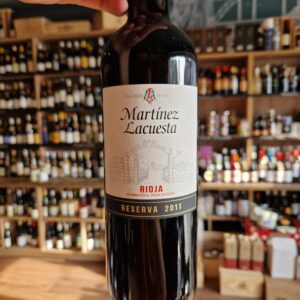 Bodegas Martínez Lacuesta was founded in 1895 in Haro by Félix Martínez Lacuesta. A winemaker, lawyer, politician and publicist, he was the first president of the National Association of Winegrowers and Wine Industries, as well as of the Rioja Wine Union. He was also one of the creators of the Regulating Board of D.O. Rioja, where he represented his fellow winemakers. The philosophy of this century-old winery is to produce the best wines from the best grapes. To do so, they have plots distributed throughout Rioja Alta, searching for the best vineyards and buying, up until this day, new plots to plant new vines. Martínez Lacuesta Reserva is a wine made from Tempranillo, Graciano and Mazuelo, from vineyards located at 450-600 metres of altitude. Their vines, of an average of 25 years old, are planted on clayey-calcareous soils. Suitable to accompany white or red meats, fishes with sauce, grilled meat or vegetables
Bodegas Martínez Lacuesta was founded in 1895 in Haro by Félix Martínez Lacuesta. A winemaker, lawyer, politician and publicist, he was the first president of the National Association of Winegrowers and Wine Industries, as well as of the Rioja Wine Union. He was also one of the creators of the Regulating Board of D.O. Rioja, where he represented his fellow winemakers. The philosophy of this century-old winery is to produce the best wines from the best grapes. To do so, they have plots distributed throughout Rioja Alta, searching for the best vineyards and buying, up until this day, new plots to plant new vines. Martínez Lacuesta Reserva is a wine made from Tempranillo, Graciano and Mazuelo, from vineyards located at 450-600 metres of altitude. Their vines, of an average of 25 years old, are planted on clayey-calcareous soils. Suitable to accompany white or red meats, fishes with sauce, grilled meat or vegetables -
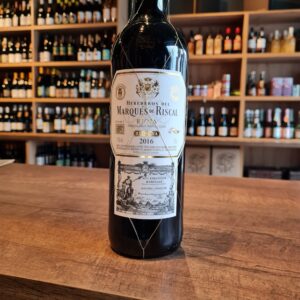 Marqués de Riscal is one of the oldest Rioja wineries. Founded in Elciego (Álava) in 1858 by Guillermo Hurtado de Amézaga. Since the beginning they have always had a clear vocation for creating the quintessential Spanish wines from Rioja. Marqués de Riscal Reserva is a red wine made with Tempranillo, Graciano and Mazuelo from vineyards that are over 40 years old, located on clayey-calcareous soils. After the harvest, the grapes ferment at a controlled temperature with a maceration of 12 days. Once the harvest has finished, the wine goes through a minimum ageing of 2 years in American oak barrels. It is left to stand in the bottle for a minimum of one year before it is launched on to the market. A wine that falls within the canons of Riojan classicism, fresh, fine, elegant and with great ageing potential.
Marqués de Riscal is one of the oldest Rioja wineries. Founded in Elciego (Álava) in 1858 by Guillermo Hurtado de Amézaga. Since the beginning they have always had a clear vocation for creating the quintessential Spanish wines from Rioja. Marqués de Riscal Reserva is a red wine made with Tempranillo, Graciano and Mazuelo from vineyards that are over 40 years old, located on clayey-calcareous soils. After the harvest, the grapes ferment at a controlled temperature with a maceration of 12 days. Once the harvest has finished, the wine goes through a minimum ageing of 2 years in American oak barrels. It is left to stand in the bottle for a minimum of one year before it is launched on to the market. A wine that falls within the canons of Riojan classicism, fresh, fine, elegant and with great ageing potential.


